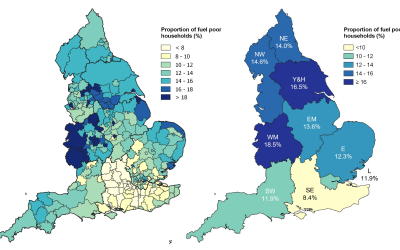It is very likely that your home may be losing heat and energy without you noticing.
Buildings typically lose heat through windows, floor gaps, roofs and walls, as heat energy is transferred through them by conduction. Cold air for instance, usually enters the house through the gaps, doorways and windows, produce convection currents and push the heat towards the roof tiles and windows.
An general estimate of over 25% from the heat produced by your boiler will most likely escape through the roof at fast rates, without the opportunity to settle and warm the property as it would be expected to.
Furthermore, over 35% of the heat will escape through walls and gaps, in and around windows and doors, and nearly 10% of heat will disappear through the floor.
Altogether, the roof, walls, windows, doors and the floor are known as the thermal envelope.
If you can slow this movement of heat from inside the house, through the thermal envelope, to the external environment, you can significantly reduce your energy costs.
Saving on Heat Expenses by reducing Heat Loss
If heat loss can be reduced, your consumption of fuel will also decrease, resulting in savings for your household.
This is also helpful from an environmental perspective, as there will be less carbon dioxide released into the atmosphere, therefore supporting the reduction of greenhouse gases associated with climate change.
There are various ways to reduce heat loss and save energy:
The most simplistic methods can involve using fitting carpets, curtains and draught excluders. Fitting reflective foil within, or on the walls, can also be a cost-effective and very useful method.
Heat loss through walls can be reduced by double glazing or insulated glazing – windows with two panes of glass that help minimising heat release as well as serve with outside noise reduction.
Heat Loss through walls can be reduced using cavity wall insulation – and insulating material which is placed into the gaps between the brick and inside wall. This will reduce convection on the outside of the home.
Loft insulation in the roof space is considered the best approach for energy efficiency in the home – being really cheap, easy to do and the payback can be reached within two years.
Walls typically come in two forms – solid and cavity walls.
Properties built prior to 1930 will generally have solid walls, whilst some houses built after this period are likely to have some form of cavity in the walls. Cavity walls are very easy to insulate – they can be injected with insulating material, which slows the movement of heat across it. This is cheap and well worth doing, again with a relatively quick payback – however a professional will need to install this for you.
Good quality insulating will help conserve heat energy within the building and release less energy into the environment, causing less pollution.
Homeowners that want to aim for minimal heat consumption may want to opt for insulation, double glazing windows and covering gaps (around doors or other areas) in order to save money in medium to long term whilst better protecting the environment.
West Midlands has highest rates of fuel poverty in England
You might be wondering why you paying more for your energy?
Simple answer: The energy price cap increased. On the first of April this year the energy price cap increased by 54%. What is a price cap?
Changes announced to energy support packages
You might be wondering why you paying more for your energy?
Simple answer: The energy price cap increased. On the first of April this year the energy price cap increased by 54%. What is a price cap?
Government Support for Household Energy Bills
What does Government offer to help with rising energy costs?






